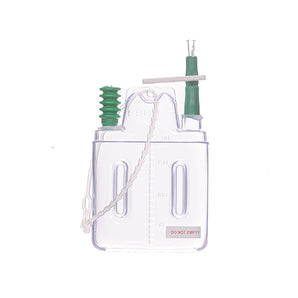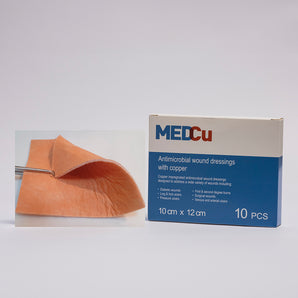Key Takeaways
- Antimicrobial dressings are designed to combat infections, maintain a moist healing environment, and support wound recovery efficiently.
- The duration of use depends on factors such as wound type, severity, exudate levels, and patient-specific conditions.
- Most antimicrobial dressings can remain in place for up to seven days, but frequent assessment is vital to ensure optimal effectiveness and avoid overuse.
- Extended use may lead to risks like microbial resistance or delayed healing, highlighting the importance of timely replacement or discontinuation.
- Regular monitoring and consulting healthcare professionals ensure safe application and adjustments based on the wound's progress.
- Transitioning to non-antimicrobial dressings is recommended when infection risks subside, helping to promote natural healing and minimise complications.
Wound care plays a crucial role in recovery, and choosing the right dressing can make all the difference. Antimicrobial dressings, designed to reduce infection risks, have become a key solution in managing wounds effectively. However, knowing how long to use these dressings is essential for ensuring optimal healing without unnecessary changes or extended wear.
These dressings, often infused with materials like copper oxide, maintain a moist environment while offering prolonged protection against bacteria. With the ability to remain in place for up to seven days, they minimise the need for frequent changes, making them both practical and efficient. But deciding the appropriate duration depends on factors such as wound type, condition, and exudate levels.
Understanding when to replace or remove antimicrobial dressings is vital for both comfort and recovery. Let’s explore how to determine the right timing to maximise their benefits while supporting the healing process.
Understanding Antimicrobial Dressings
Antimicrobial dressings are specialised wound care products designed to combat infections and support healing. They are vital for treating wounds that are prone to bacterial, fungal, or viral contamination.
What Are Antimicrobial Dressings?
Antimicrobial dressings are medical devices infused with agents like copper, silver, or iodine to prevent and control microbial growth in wounds. These dressings often incorporate layered materials to ensure added functionality. For instance, MedCu antimicrobial wound dressings use a 2- or 3-layer structure. The inner layers absorb wound exudate, while the top layer containing copper oxide provides broad-spectrum antimicrobial protection. Such dressings are frequently used to manage acute and chronic wounds, including diabetic ulcers, burns, and surgical sites.
How Do They Work?
Antimicrobial dressings effectively mitigate infection risks by directly targeting microorganisms at the wound site. Copper or silver ions disrupt bacterial cell membranes, inhibit DNA replication, and neutralise microbial activity. Additionally, these dressings maintain a moist environment favourable for healing by promoting collagen and elastin production. This dual action aids in tissue regeneration, reduces scarring, and eliminates the need for frequent dressing changes, extending usability to up to seven days in many cases.
Factors Affecting Duration Of Use
The time antimicrobial dressings are applied depends on various wound and patient factors. Assessing these ensures optimal healing and reduces risks of prolonged or inadequate use.
Type Of Wound
Chronic wounds like diabetic ulcers and acute wounds such as surgical incisions require different application durations. Chronic wounds often sustain antimicrobial dressings for extended periods, while smaller acute wounds may need only short-term use. Determining the appropriate type helps ensure the dressing promotes recovery without overuse.
Severity And Infection Level
Heavily infected wounds or those with extensive bacterial contamination typically necessitate longer-duration antimicrobial treatment. Mildly infected wounds, however, heal faster with shorter dressing application. Dressing materials like silver or iodine are selected based on the scope of microbial activity.
Patient-Specific Considerations
Patients' overall health conditions influence dressing duration. Factors such as immune function, chronic illnesses like diabetes, and skin sensitivity play critical roles. Monitoring these personal dynamics helps professionals adjust dressings to fit individual recovery needs without risking complications.
Guidelines On How Long To Use Antimicrobial Dressing
Determining the appropriate duration for using antimicrobial dressings is essential for effective wound management. The length of use depends on the wound's condition, type, severity, and exudate levels.
Recommendations From Medical Experts
Experts suggest changing antimicrobial dressings when they become saturated with exudate or after a specific period. Many dressing types, such as copper oxide-impregnated options, can remain on the wound for up to seven days based on the wound's healing progress. However, chronic or heavily infected wounds might require more frequent monitoring and replacements to maintain proper antimicrobial efficacy. Consulting a healthcare professional ensures the wound receives optimal care.
Common Practices In Wound Care
Current wound care practices encourage minimal dressing changes to reduce disruption of the healing process. Extended-wear dressings, such as certain antimicrobial dressings, provide comfort and efficacy while minimising frequent handling. For instance, antimicrobial options maintain a moist environment, reducing infection risks while promoting granulation. Regular assessment of the wound is vital, particularly for wounds with fluctuating exudate levels or infection concerns.
Potential Risks Of Prolonged Use
Antimicrobial dressings are essential for controlling infections and aiding wound healing, but extended use may create challenges. Understanding these risks ensures their appropriate and effective usage.
Resistance Development
Prolonged exposure to antimicrobial dressings may encourage microorganisms to develop resistance. Repeated use of medical devices that incorporate agents like silver or iodine can result in reduced efficacy over time, limiting options for treating infections. Overusing these products increases the risk of selecting resistant strains, complicating wound management and requiring alternative, potentially less effective solutions. Regular assessment and rotation of antimicrobial strategies may help mitigate this risk.
Impact On Healing Process
Extended application of antimicrobial dressings, if unnecessary, could affect the natural healing process. These dressings, while effective, may delay epithelialisation if they disrupt cell growth or create overly aggressive antimicrobial conditions. For example, wounds with excessive exudate might benefit initially but may face slower regeneration with continuous usage. Monitoring the wound's progress and transitioning to non-antimicrobial options at the right time can optimise healing outcomes.
Tips For Safe And Effective Use
Using antimicrobial dressings requires diligence to promote healing and minimise risks. Proper monitoring and knowing when to switch or discontinue their application ensure optimal outcomes for various wound types.
Monitoring Progress
Regular assessment identifies how the wound responds to antimicrobial dressings. Factors like wound size, exudate levels, and presence of odour or redness provide critical information. If signs of infection persist, such as increased swelling or warmth, additional medical input may be needed.
Documenting changes ensures continued effectiveness. Tracking healing trends, like reduced exudate or visible granulation tissue, helps determine if the dressing supports recovery or if modifications are necessary. Frequent observations avoid prolonged misuse and prevent microbial resistance from developing.
Integrating check-ups into care routines guarantees safety. By consulting healthcare providers, we ensure correct application timings and adjustments. Dynamed Pharmaceuticals and other providers of advanced wound care solutions recommend professional guidance in wound evaluation during antimicrobial dressing treatments.
When To Switch Or Discontinue
Transitioning to a non-antimicrobial dressing might be appropriate when the wound no longer shows infection risks or substantial healing progress occurs. Antimicrobial wound dressings are ideal for reducing bacterial loads, but overuse may hinder epithelialisation and delay closure.
We should remove these dressings if they become saturated or fail to absorb exudate properly. Most are suitable for up to seven days, though specific factors like infection severity or dressing type may necessitate earlier replacement, as medical devices should always align with the wound's condition.
Discontinuation depends on signs of complete wound granulation. Switching can also be crucial when prolonged use raises concerns about resistance or adverse reactions to ingredients like iodine or silver. For effective care, it's vital to follow supply instructions and consult specialists for individual cases.
Final Thoughts
Understanding how long to use antimicrobial dressing is essential for effective wound care and optimal healing. By considering factors like wound type, severity, and exudate levels, we can tailor dressing use to individual needs while minimising risks like microbial resistance or delayed recovery. Regular monitoring and timely adjustments ensure these dressings remain beneficial throughout the healing process.
Consulting healthcare professionals is key to making informed decisions about dressing duration and transitioning to non-antimicrobial options when appropriate. With diligent care and proper guidance, we can support faster recovery and improved outcomes for every wound.
Visit Dynamed Pharmaceuticals
Phone: 0861 00 00 43
Website: dynamed.co.za
Email (Sales): sales@dynamed.co.za
Email (Info): info@dynamed.co.za
Google Maps: Find us here
Frequently Asked Questions
What are antimicrobial dressings?
Antimicrobial dressings are specialised wound care products infused with agents such as silver, copper, or iodine. They are designed to prevent and control bacterial, fungal, or viral infections while promoting a moist environment for optimal healing.
How do antimicrobial dressings work?
Antimicrobial dressing work by targeting and killing microorganisms at the wound site. They disrupt bacterial cell membranes, reduce infection risks, and maintain a moist environment, which aids tissue regeneration and wound closure.
When should antimicrobial dressings be replaced?
Antimicrobial dressing should be replaced when they become saturated, lose their effectiveness, or after a specific duration, usually up to seven days. Regular monitoring of the wound ensures timely changes for better healing.
Can antimicrobial dressings be used for all wounds?
While antimicrobial dressings are effective for wounds at high risk of infection, they may not be necessary for clean, non-complicated wounds. A healthcare professional should assess the wound to determine appropriate treatment.
How long can antimicrobial dressings be used?
The duration of use depends on the wound’s type, condition, and severity. Chronic or heavily infected wounds may need prolonged use, whereas smaller, acute wounds typically require shorter applications.
What are the risks of prolonged use of antimicrobial dressings?
Extended use can lead to microbial resistance, reduced effectiveness of antimicrobial agents, and delayed natural healing. Monitoring and transitioning to non-antimicrobial dressings when healing improves is advised.
Are antimicrobial dressings suitable for chronic wounds?
Yes, antimicrobial dressing are ideal for chronic wounds, such as diabetic ulcers, as they reduce infection risks and support long-term healing. The dressing type and duration depend on wound severity and exudate levels.
Do antimicrobial dressings require frequent changing?
Most antimicrobial dressings do not require frequent changes and are designed for extended wear, lasting up to seven days. However, wounds with fluctuating exudate levels or infections may need more frequent assessment and replacements.
Can antimicrobial dressings delay wound healing?
If used unnecessarily or for prolonged periods, antimicrobial dressing may hinder natural healing by affecting tissue regeneration. Switching to non-antimicrobial options when appropriate encourages better recovery.
Should I consult a healthcare professional before using antimicrobial dressings?
Yes, consulting a healthcare professional is crucial. They can assess your wound, recommend the right dressing type, and ensure optimal use to minimise risks like microbial resistance or delayed healing.






